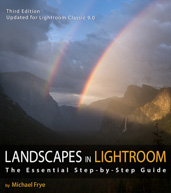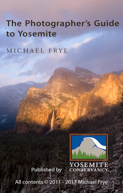In the Moment:
Michael Frye's Landscape Photography Blog
by Michael Frye | Mar 31, 2015 | Night Photography
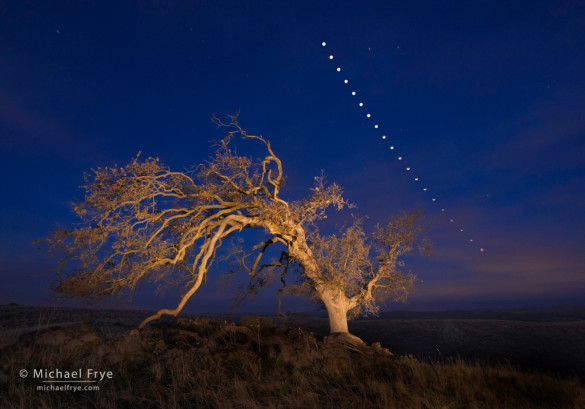
Oak tree and lunar eclipse sequence, Mariposa County, Sierra foothills, December 2011
Another total lunar eclipse will be visible in western North America this Saturday morning, April 4th. This is the third lunar eclipse in a sequence of four: we had two last year, and there will be another one on September 27th this year. But after that you won’t be able to see another total lunar eclipse in North America until 2018.
This upcoming eclipse will be brief; the total eclipse will last only five minutes! But for photography that’s enough. Here in California the eclipse will be visible in the west-southwest, about 18 degrees above the horizon, just before dawn. Since the moon will be low in the sky, you might be able to photograph it next to an interesting foreground object. You can find more details about this eclipse here.
For precise guidance about the moon’s position in relation to the landscape, I recommend consulting PhotoPills or The Photographer’s Ephemeris. Here’s the timing for the eclipse:
(more…)
by Michael Frye | Mar 29, 2015 | Composition
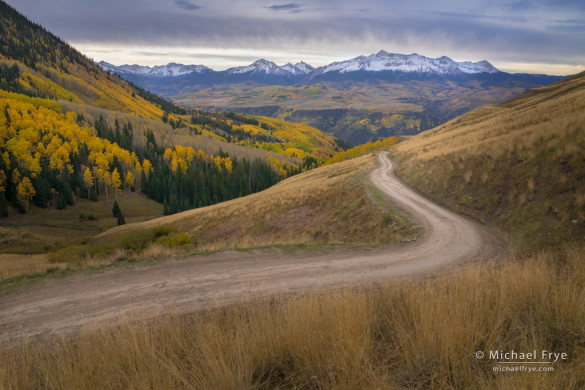
Backcountry road in autumn with the San Miguel Range in the distance, Uncompahgre NF, CO, USA
Varying the focal length of your lens allows you change a composition easily without moving your feet. This is certainly convenient, and sometimes it’s essential: there may be only one suitable camera position, which means changing lenses or zooming is the only way to alter how much of the scene will be visible in your photograph.
But using a wider or longer lens also changes the perspective. Understanding how this works allows you to control the sense of depth in your images.
(more…)
by Michael Frye | Mar 22, 2015 | Photography Tips
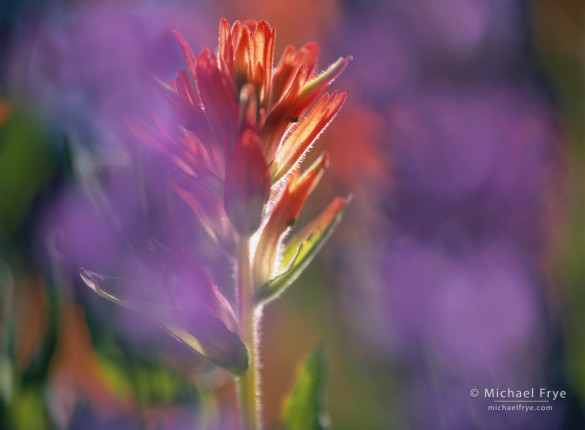
Paintbrush and lupine near Tioga Pass, Yosemite NP, CA, USA
Although spring officially began two days ago, here in California we’ve had springlike conditions since February, while in the northeast spring is just a rumor. But flowers will bloom everywhere, eventually, and it’s a great season for photography.
Though I usually prefer to photograph flowers as part of a landscape, sometimes I enjoy doing closeups as well. This image was made in the Yosemite high country a few years ago, with part of a paintbrush in focus, and out-of-focus lupines in the foreground. This technique of using out-of-focus flowers to create a wash of color, and an impressionistic look, is fun to try, but tricky. It requires a densely-packed group of flowers, and a lot of experimentation. Here are some tips:
(more…)
by Michael Frye | Mar 21, 2015 | Announcements
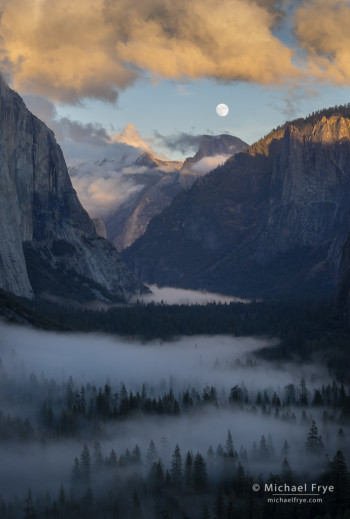
Moon rising above the Valley, Yosemite National Park
— Michael Frye
by Michael Frye | Mar 16, 2015 | Announcements
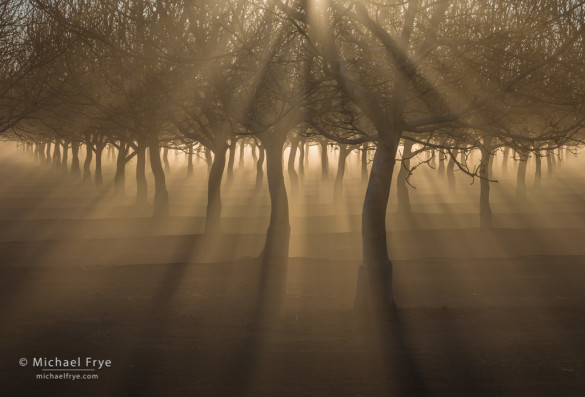
Orchard with sunbeams and fog, Sacramento Valley, California
I’m pleased to announce that once again The Ansel Adams Gallery is sponsoring a special print sale of two of my photographs, at 25% off the normal price. The two images we selected for this offer are Orchard With Sunbeams and Fog, Sacramento Valley, California, and Moon Rising Above the Valley, Yosemite National Park. These two photographs have never been exhibited at a gallery or sold before, although, as many of you know, both of these images were voted by my readers to be included in my best images of 2014, and the Orchard With Sunbeams and Fog photograph was the top vote-getter.
My signed, limited-edition 16×20 prints usually sell for $325, but during this sale you can get one for only $244. Or you can purchase a 20×24 print, normally $475, for only $356. This is a rare chance to purchase one of my photographs at a reduced price, but the sale lasts for just six days, until Sunday, March 22nd, at 6:00 PM Pacific time. Visit the Ansel Adams Gallery website to purchase a print or get more details.
Here are the stories behind the photographs:
(more…)
by Michael Frye | Mar 14, 2015 | Yosemite Photo Conditions
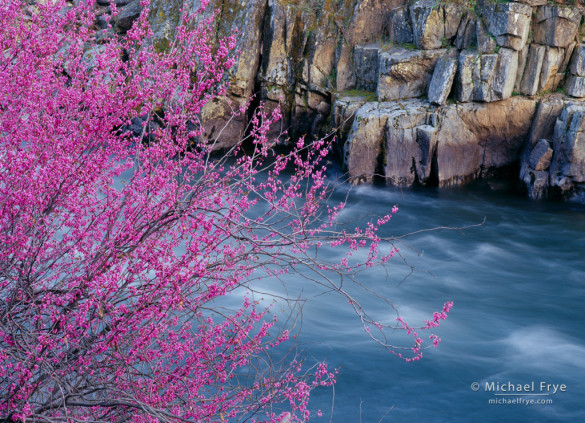
Redbud, rocks, and the Merced River (April 2002)
I had a chance to drive up the Merced River Canyon (west of Yosemite along Highway 140) yesterday to check on the flowers. It’s not turning into a good year for poppies in this area. There are scattered patches of poppies in shadier spots, but all the south-facing slopes look very dry. There are very few poppies near the beginning of the Hite’s Cove Trail, on Grandy’s Hill, or any of the other prime poppy locations.
But the redbuds are looking great. Overall, they’re close to their peak now, or maybe just before peak. The redbuds in the western half of the canyon are a little further along, and in prime condition, with most in full bloom, less than 5% leafing out, and maybe 10-20% not quite in full bloom yet. The redbuds in the eastern half of the canyon are not quite at peak yet. I saw one or two leafing out, but maybe 60% were in full bloom, while 40% were still on their way. But there are many vibrant, beautiful specimens throughout the canyon, and it looks like one of the better years for redbuds I’ve seen lately.
(more…)
by Michael Frye | Mar 12, 2015 | Composition
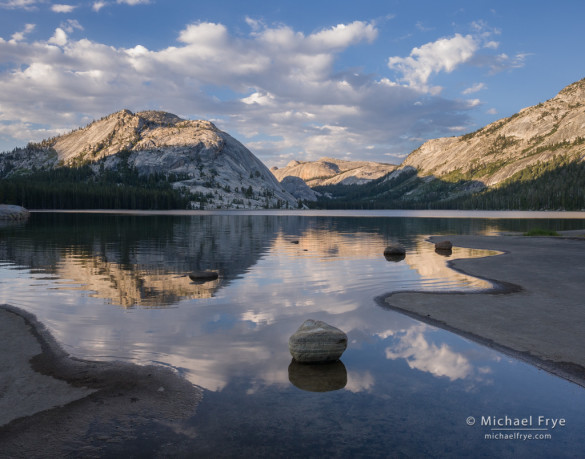
Clouds and reflections, Tenaya Lake, Yosemite
Does every landscape photograph need a foreground? Not always. Some of the world’s most memorable landscape photographs lack any foreground – like Moon and Half Dome by Ansel Adams, or Galen Rowell’s Last Light on Horsetail Fall (go to page 2).
On the other hand, many classic landscape images do have foregrounds – prominent ones – like another Ansel Adams photograph, Mount Williamson from Manzanar, or many images by landscape master David Muench.
So how do you know when to include a foreground in your own landscapes? Ask yourself these questions:
(more…)
by Michael Frye | Mar 5, 2015 | Yosemite Photo Conditions
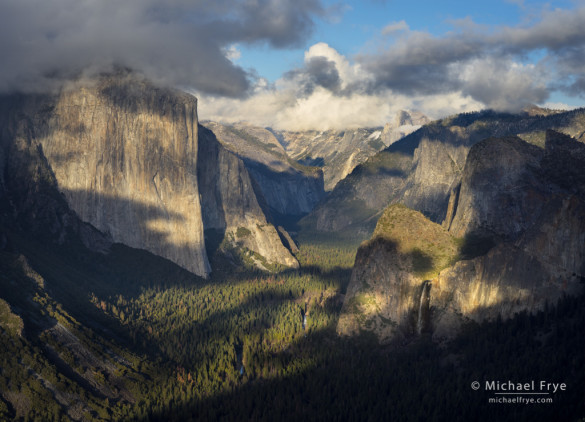
Late afternoon view of Yosemite Valley from near Old Inspiratoin Point, Monday afternoon
It’s the time of year when both El Capitan and Bridalveil Fall get late-afternoon sunlight when seen from the west end of Yosemite Valley. In winter, El Cap get that late-day light, while Bridalveil stays in the shade. In summer it’s the opposite, with the cliffs to the right of Bridalveil Fall (like the Leaning Tower) receiving the last glow in the evening, while El Cap goes into shade earlier. But in early March (and around the end of September) the light balances well on both sides of the valley, making it a great time of year for photographs from Tunnel View and Gates of the Valley (aka Valley View).
Knowing this, I watched the weather closely on Monday. Some showers moved through, and it seemed like the last chance of seeing interesting clouds for awhile, so I decided to hike up above Tunnel View to a spot near Old Inspiration Point (I’ve described previous journeys up this trail here and here). I got there in time to catch one moment with beautiful cloud shadows. I especially like the shadow near the bottom of El Capitan (in the photo above).
(more…)
by Michael Frye | Mar 1, 2015 | Yosemite Photo Conditions
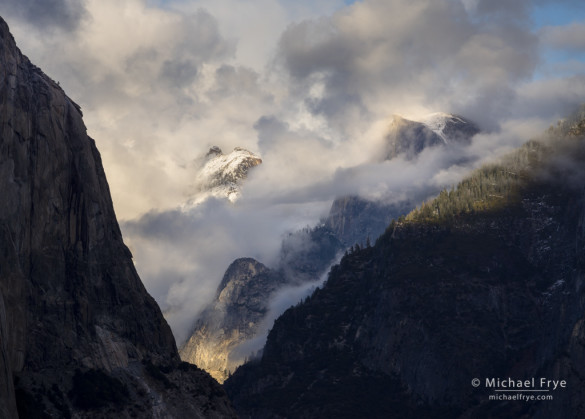
Half Dome and clouds from Tunnel View, Yosemite NP, CA, USA
“Time, geologic time, looks out at us from the rocks as from no other objects in the landscape… Even if we do not know our geology, there is something in the face of a cliff and in the look of a granite boulder that gives us pause.” — John Burroughs
Photography has a great ability to showcase contrasting textures, which is perhaps why hard rocks and soft clouds fit together so well. In Yosemite the rocks are a given; they’re always there. It’s the clouds that are more elusive, especially during these dry years.
(more…)
by Michael Frye | Feb 24, 2015 | Yosemite Photo Conditions
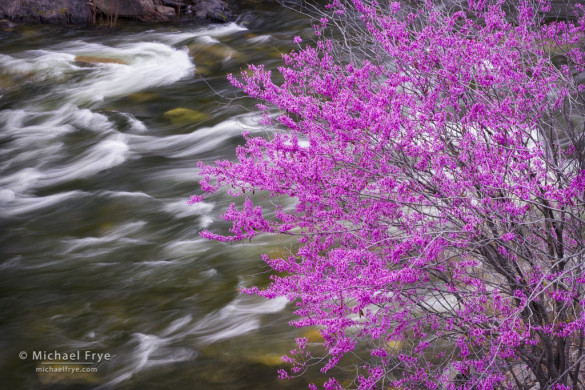
Redbud along the Merced River, Merced River Canyon, March 2013
February has been exceptionally warm, so I probably shouldn’t be surprised to see signs of spring already. But redbuds? In February? Apparently so. Claudia drove up to Yosemite Valley on Saturday, and reported seeing redbuds and a few poppies blooming in the Merced River Canyon west of the park. It’s not unusual to see poppies in late February, but the redbuds are a month early. Claudia said that only a couple of them were in full bloom, but many more were starting.
Temperatures dropped significantly over the weekend, and I’m not sure how that will affect the redbuds, or the poppies. Under normal circumstances the redbuds would continue to progress, and reach peak in perhaps a week or so. But these aren’t normal circumstances, so all bets are off.
(more…)

















